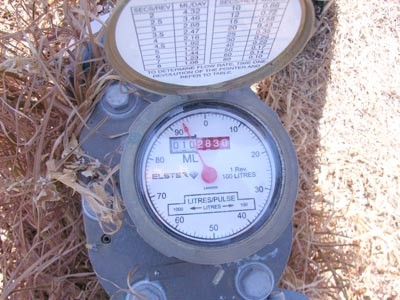Revenue and Consumption Factors
There is a cost associated with installing meters, but there is also a greater revenue potential for the utility, as high water-using customers will now be billed for the water that they actually use. However, water agencies should be prepared for the reductions in water consumption after metered billing is implemented. The new volumetric water pricing should be based on the expected reduction of water usage (not current usage) and also designed to cover the general overhead costs of the water utility. This requires the utility to carefully calculate the fixed costs versus avoided costs of conservation. The meters must also be properly sized for the customer’s volume of water usage.
Cost. Meters that meet the American Water Works Association’s ![]() standards and state regulatory requirements cost between $40 USD (residential size) to $2,000+ USD (industrial size). The cost to install a meter where none exists can range between $180 to $800+ USD per meter, depending upon the location of the service line and the affected hardscapes. It is more costly to install meter boxes and meters in established areas where street, sidewalks and landscape must be excavated and replaced. Many agencies implementing metering have learned to schedule meter installations prior to regularly schedule street repairs and resurfacing.
standards and state regulatory requirements cost between $40 USD (residential size) to $2,000+ USD (industrial size). The cost to install a meter where none exists can range between $180 to $800+ USD per meter, depending upon the location of the service line and the affected hardscapes. It is more costly to install meter boxes and meters in established areas where street, sidewalks and landscape must be excavated and replaced. Many agencies implementing metering have learned to schedule meter installations prior to regularly schedule street repairs and resurfacing.
Sizing, Accuracy and Sensitivity. Proper meter sizing and type is important both for water conservation and correct revenue generation for a water utility. The inside diameter of the water supply pipe is used to classify meter size. Meters vary in sensitivity by size and design. Improper meter selection for the customer usage pattern can cause the meter to not register the full amount of water consumed.
Single-family homes typically use a 5/8” meter (1.59 cm), though 3/4” (1.91 cm) or 1” meters (2.54 cm) are also used for larger homes. Small commercial businesses generally need meter sizes of 5/8” to 1.5” (1.59 cm to 3.81 cm). These meters are usually of the “positive-displacement” design. This design of meter is reasonably accurate at the normal flows of a home or small business. The mechanisms of positive-displacement meters unduly impede water flow where high velocity is needed, such as at larger commercial, institutional and industrial facilities.
 In general, the larger the meter, the less sensitive the meter is to small volumes of water passing through the mechanism. A typical residential meter of 5/8” or 3/4” (1.59 cm or 1.91 cm) will only record usage when the flow rate is greater than one pint of water per minute. Meter sensitivity decreases with age; a ten year old meter might be only recording flows greater than two or three pints per minute.
In general, the larger the meter, the less sensitive the meter is to small volumes of water passing through the mechanism. A typical residential meter of 5/8” or 3/4” (1.59 cm or 1.91 cm) will only record usage when the flow rate is greater than one pint of water per minute. Meter sensitivity decreases with age; a ten year old meter might be only recording flows greater than two or three pints per minute.
If the facility requires greater water flow, the meter size will range from 1.5” to 12” (3.81 cm to 30.5 cm), using a “multi-jet” or “turbine” design. Often a large facility (such as a hospital, office building, school or factory) will need several meters for water supplied to different zones or uses. These types of meters actually measure the velocity of the water, not the volume. The meter is calibrated to record the volume, calculated by multiplying the measured water velocity by the area of chamber the water passes through. These meters are very accurate at high flows, but the sensitivity is less than 1 to 3 gallons per minute (3.78 lpm to 11.35 lpm) at low flows. This loss of sensitivity at low flows can cause a water utility to lose revenue when the meter fails to record the customer’s total water usage. This problem is most acute where water flows are highly variable during any given 24 hour period.
Compound meters use a combination of multi-jet or turbine meter for high flow conditions, and then switch to positive displacement mechanism when water flows below a preset rate. A simple check valve switches the water flow accordingly. Combination meters are a good strategy for the water purveyor to meet the peak water demand for its customer while assuring accurate billing of all water consumed. Some water purveyors have experienced more than 10% increase in revenue after installing compound meters on single metered apartment buildings.
In general, the larger the meter, the less sensitive the meter is to small volumes of water passing through the mechanism. A typical residential meter at 5/8” or 3/4” (1.59 cm or 1.91 cm) will only record usage when the flow rate is greater than one pint of water per minute. Also, meter sensitivity decreases with age. A 10 year old 5/8” (1.59 cm) meter usually only records flows greater than 2 pints per minute (.95 lpm), depending on usages and water quality.
Meter sensitivity is a very important issue for water conservation and water purveyor revenues. Water that passes through the meter unrecorded is essentially a cost to the water purveyor without revenue. More importantly, a meter of poor sensitivity will allow leaks to be unnoticed by the user and the water purveyor.





